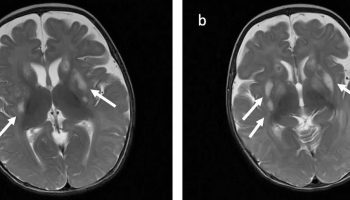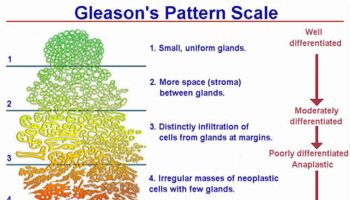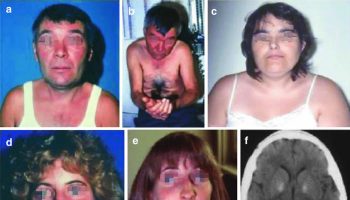Epithelioid hemangioendothelioma
Epithelioid hemangioendothelioma also called EHE, is a rare type of vascular tumor that affects the epithelial cells, which line the inside of blood vessels 1. Epithelioid hemangioendothelioma can occur at any age, but usually in the adulthood. Epithelioid hemangioendothelioma tumors most commonly affect the soft tissues and various organs including liver, lungs, bones and skin 2. Epithelioid hemangioendothelioma is usually considered an intermediate vascular neoplasm between a benign hemangioma and a highly aggressive angiosarcoma 3. Epithelioid hemangioendothelioma tumors are malignant (cancerous). But they are slow-growing and do not usually spread (metastasize) as quickly as other cancers. Because they are so rare, they can go undetected for a long time before being diagnosed. This gives the tumors time to spread to surrounding tissues.
Epithelioid hemangioendothelioma tumors affect each person differently. Some people can live with these slow-growing tumors for years with only minor disruption to daily life. Sometimes the tumors even go away on their own. Less commonly, the tumors grow and spread quickly.
The cause of epithelioid hemangioendothelioma is not known. Epithelioid hemangioendothelioma is histologically characterized by cords and nests epithelioid cells with intracytoplasmic vacuoles in a myxohyaline stroma. Very rarely, the tumor may be present with spindle cells and multinucleated osteoclast-like giant cells 4. The unusual histological appearance may pose a great diagnostic challenge. It may be easily misdiagnosed, especially if the specimen is limited or from fine-needle aspiration.
Epithelioid hemangioendothelioma treatment varies based on tumor location and grade (how severe it is). A common treatment is surgery. The surgeon will remove as much surrounding tissue as needed to provide a margin of healthy tissue. Doctors may also use radiation, chemotherapy or targeted therapies to treat epithelioid hemangioendothelioma.
A person with epithelioid hemangioendothelioma in the liver may receive a liver transplant.
In some cases, if the tumor is spreading slowly, your child’s doctor may take a wait-and-see approach to monitor tumor growth rather than subject your child to the risks and side effects of treatment.
How common is epithelioid hemangioendothelioma?
Epithelioid hemangioendothelioma is very rare, with only one in every one million people diagnosed with this cancer worldwide. Around 20 cases are diagnosed in the United States per year 5. Because epithelioid hemangioendothelioma can be hard to diagnose, the actual number of people with epithelioid hemangioendothelioma may be higher.
Does epithelioid hemangioendothelioma run in families?
No, epithelioid hemangioendothelioma is not passed down in families.
Epithelioid hemangioendothelioma causes
Scientists think that in epithelioid hemangioendothelioma, chromosomes (the parts of your cells that contain all of your genes) break apart and get put back together in the wrong way. This can cause cells to not function like they should. In most epithelioid hemangioendotheliomas, the WWTR gene that makes the TAZ protein joins with the CAMTA1 gene. In a small number of epithelioid hemangioendotheliomas, the YAP gene joins with the TFE3 gene. TAZ and YAP work together to drive growth and scientists are looking at ways to block them. Doctors may look for these changes in chromosomes to confirm that the cancer is epithelioid hemangioendothelioma.
Epithelioid hemangioendothelioma symptoms
People with epithelioid hemangioendothelioma will have different symptoms depending on where the tumor is located. The most common symptoms include the following:
- Weight loss
- Pain and swelling in the tumor area, such as discomfort or pain in the abdomen
- Nausea
- Mass in the tumor area
- Skin lumps and bumps that may appear red or blue
- Cough or trouble breathing
- Coughing up blood
- Fever
- Enlarged organ affected by the tumor, such as the liver or spleen
- Problems moving or walking, such as if the tumor occurs in the spine
- Broken bones
Epithelioid hemangioendothelioma diagnosis
How epithelioid hemangioendothelioma is diagnosed:
- Imaging: If you have symptoms of epithelioid hemangioendothelioma, your doctor will take images of the tumor using MRI, CT, X-ray, or PET scan to look at the size of the tumor and where it is in the body. They will also check for signs that the tumor has spread to other parts of the body.
- Biopsy: To check if the tumor is epithelioid hemangioendothelioma, your doctor will perform a biopsy, taking a small sample from the tumor with a needle. An expert, called a pathologist, will study cells from the sample under the microscope to see what kind of tumor it is.
Epithelioid hemangioendothelioma treatment
Since epithelioid hemangioendothelioma is so rare, there is no standard treatment. Treatment for each person is different and depends on where in the body epithelioid hemangioendothelioma starts, if it has spread (metastasis) and specific individual factors. You should see a doctor who is an expert in tumors that form in blood vessels to decide the best approach for your cancer.
Surgical resection, radiotherapy, and chemotherapy all have been used to treat these masses, although studies on survival have yet to be conducted to delineate various treatment regimens. Surgery is the preferred treatment as long as the entire tumor could be removed, since there’s little chance of growing back. If it’s impossible to remove the whole tumor surgically, or if there are multiple tumors in several locations, several medications will be commended to slow the growth of the tumor by interfering with abnormal cell growth, ie, anti-angiogenic agent, vincristine, interferon, Rapamycin, radiation and other treatments.
- Surgery: Surgery is most often used to treat epithelioid hemangioendothelioma that has not spread to other parts of the body. Surgery can also be used with chemotherapy and radiation therapy.
- Radiation therapy: Doctors sometimes use radiation therapy to treat epithelioid hemangioendothelioma, with or without surgery. Radiation therapy is most often used to treat epithelioid hemangioendothelioma that grows in the bones. Because radiation therapy can cause other cancers in the future, it is important to discuss this option with your doctor.
- Chemotherapy: Doctors may use chemotherapy with other treatments. It is important to discuss the side effects with your doctor.
- Targeted therapy: Because epithelioid hemangioendothelioma is made up of cells that form blood vessels, some doctors are trying treatments that target tumor blood vessels. These treatments are called anti-angiogenics.
- Immunotherapy: Immunotherapy uses different treatments to help the body’s immune system kill tumor cells.
- Watch and wait: In some cases, the tumor grows very slowly, or even shrinks without any treatment. In this case it may be safest for your doctor to check your tumor often without treating it.
- Embolization: In some cases, blocking the blood flow to the tumor, called embolization, can help shrink and kill the tumor.
Epithelioid hemangioendothelioma prognosis
The estimate of how a disease will affect you long-term is called prognosis. Every person is different and prognosis will depend on many factors, such as:
- Where the tumor is in your body
- If the cancer has spread to other parts of your body
- How much of the tumor was taken out during surgery
- If you want information on your prognosis, it is important to talk to your doctor.
Doctors estimate survival rates by how groups of people with epithelioid hemangioendothelioma have done in the past. Given that there are so few epithelioid hemangioendothelioma patients, survival rates may not be very accurate and may not consider newer treatments being developed.
The course of the disease for people with epithelioid hemangioendothelioma can be hard to predict. Some people live a long time, even without treatment. In other cases, the cancer grows quickly and spreads, even with treatment. epithelioid hemangioendothelioma that has spread to other parts of the body does not always lead to a poor prognosis. Some of this depends on where the epithelioid hemangioendothelioma is located, so it is very important to discuss your case with you doctor to understand your prognosis.
Epithelioid hemangioendothelioma survival rate
The prognosis of epithelioid hemangioendothelioma is not sound, almost a third of epithelioid hemangioendotheliomas develop metastases in regional lymph nodes (at least 50% + of all metastatic cases) or in the lungs, liver or bones. Patients who develop metastases have a 50% five-year survival rate.
Survival rates for epithelioid hemangioendothelioma vary depending on the tumor location and type of treatment:
- Liver epithelioid hemangioendothelioma: A 2006 study of 434 people with this type of epithelioid hemangioendothelioma found five-year survival rates of 55% in people with liver transplants and 30% in people who had chemotherapy or radiation. Two large-scale studies since then have shown even higher rates of survival for people who received liver transplants.
- One estimate places the mortality rate for soft-tissue epithelioid hemangioendotheliomas at 13% to 18%.
- Disease-specific mortality rate for epithelioid hemangioendothelioma in the lung and liver is 40% and 65% respectively 6.
According to Mentzel et al. 7 and Weiss et al. 8, the majority of epithelioid hemangioendotheliomas have a relatively better clinical course than highly aggressive angiosarcoma. However, if the tumor shows marked cellular atypia, mitotic activity (>1 mitosis per 10 HPF), necrosis and extensive spindling, it may have a more aggressive course 7. Deyrup et al. 9 also reported that epithelioid hemangioendothelioma tumor over 3.0 cm had poor prognosis. But, it is still unclear whether the presence of osteoclast-like giant cells is associated with prognosis.
- Epithelioid Hemangioendothelioma. https://www.stjude.org/disease/epithelioid-hemangioendothelioma.html[↩]
- Gherman CD, Fodor D: Epithelioid hemangioendothelioma of the forearm with radius involvement. Diagn Pathol. 2011, 6: 120-10.1186/1746-1596-6-120.[↩]
- Goldblum JR, Weiss SW: Hemangioendothelioma; vascular tumor of intermediate malignancy. Enzinger and Weiss’s soft tissue tumors. Edited by: Mosby CV. 2001, St. Louis: Elsevier, 891-915. 4[↩]
- Suster S, Moran CA, Koss MN: Epithelioid hemangioendothelioma of the anterior mediastinum. Clinicopathologic, immunohistochemical, and ultrastructural analysis of 12 cases. Am J Surg Pathol. 1994, 18: 871-881. 10.1097/00000478-199409000-00002[↩]
- Epithelioid Hemangioendothelioma (EHE). https://www.cancer.gov/pediatric-adult-rare-tumor/rare-tumors/rare-vascular-tumors/epithelioid-hemangioendothelioma[↩]
- Weiss, S.W., Goldblum, J.R., Epithelioid Hemangioendothelioma, in Enzinger and Weiss’s Soft Tissue Tumors. 2008, Mosby: Philadelphia. p. 681-687.[↩]
- Mentzel T, Beham A, Calonje E, Katenkamp D, Fletcher CD: Epithelioid hemangioendothelioma of skin and soft tissues: clinicopathologic and immunohistochemical study of 30 cases. Am J Surg Pathol. 1997, 21: 363-374. 10.1097/00000478-199704000-00001[↩][↩]
- Weiss SW, Ishak KG, Dail DH, Sweet DE, Enzinger FM. Epithelioid hemangioendothelioma and related lesions. Semin Diagn Pathol. 1986;3(4):259–287.[↩]
- Deyrup AT, Tighiouart M, Montag AG, Weiss SW: Epithelioid hemangioendothelioma of soft tissue: a proposal for risk stratification based on 49 cases. Am J Surg Pathol. 2008, 32: 924-927. 10.1097/PAS.0b013e31815bf8e6[↩]





